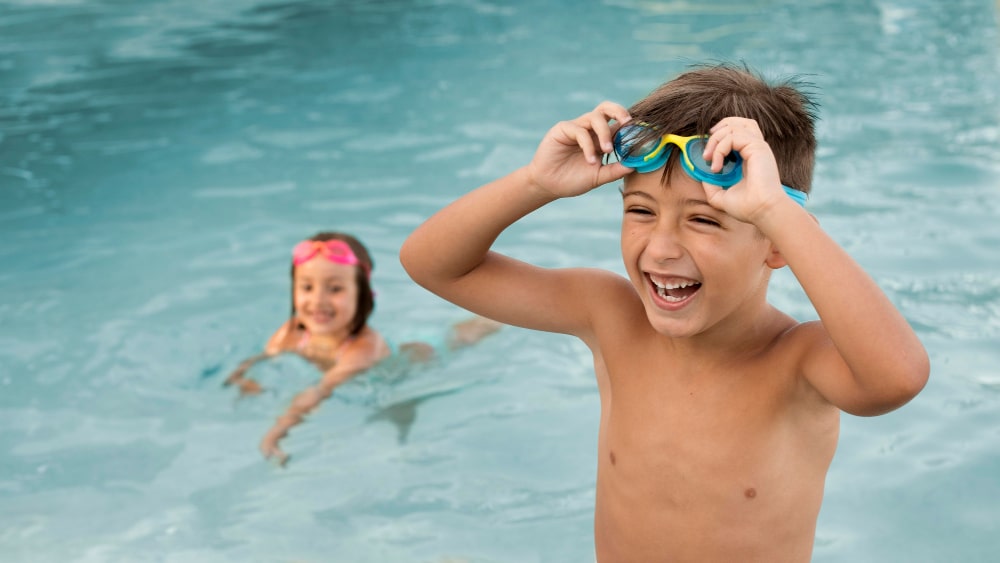
The Benefits of Swimming for Kids: Why It Matters and How to Help Them Thrive in the Water.
Swimming is more than a fun way to spend some free time. It is a lifelong skill that will support your child’s health, confidence, and safety. Whether your child is splashing in the shallow end or racing laps, swimming offers big benefits for both their body and their mind.
I am writing this as the best blog for parents and their children to explain why swimming is so important:
Exercise
You really cannot beat the benefits offered by physical fitness in the water. The movement in the water provides a full-body workout. All parts of your body are used to propel through the water, so it builds strength in the arms, legs, and core without putting stress on joints. Regular swimming improves cardiovascular fitness and stamina. It also helps build better motor skills.
The natural movements in swimming, such as kicking, arm stretching, and breathing rhythms, all function to boost coordination and body awareness.
The water provides a natural resistance to those movements, and this helps promote good posture.
You may also like: The Great American Pastime
Mental and Emotional Growth
There are many studies that prove the benefits of exercise on mental health. By providing children with this outlet, they will be happier, better-adjusted people. By mastering new skills, such as learning how to submerge their head under water, how to float, or how to dive, children gain confidence and independence.
Another benefit of water is its function in stress relief. Water is calming. We all know this. To relieve tension, adults will often take a bath. And, when children are getting too squirrely, we often pop them in the bathtub to assist with the transition to sleepy-time.
Being in water and swimming helps kids relax and manage big feelings. I can’t think of one time I have been swimming in a pool where I did not emerge from the water more relaxed and at peace.
It’s truly magical what the water provides.
Discipline, Teamwork, & Social Skills
Swimming promotes communication and cooperation through interactions with instructors and fellow students in a group lesson format. Children must learn to focus when listening to an instructor. They also learn to take turns and encourage others. Often, goals are set, and this teaches children about meeting milestones to level up in swim classes or to beat a personal best in lap swimming.
Just the act of swimming a full lap teaches perseverance. By joining a swim team or partaking in classes, children can gain a sense of belonging, and this is instrumental in their development.
Entertainment
Swimming is fun! When luring our children off their electronics and out of the home, just about every child will run for the door when they hear they are going swimming.
Safety for Life
As a parent, I am shocked to know how many children and adults cannot swim! Even more shocking is how many people will partake in water activities without knowing how to swim. I have been on water rafting trips and boating trips with people who are not water safe.
Knowing how to float rather than sink is necessary. Accidental drowning is a realistic risk for anyone, even people who know how to swim. But obviously, water competence reduces drowning risk and prepares kids for water-based activities like boating, surfing, and snorkeling.
How to Help Your Child Become a Proficient Swimmer
- Start early and young: The best way for your children to become comfortable in the water is to start early. If you make it a positive experience, they will naturally gravitate to the water.
- Spend lots of time in the water: If you only visit a pool once a year on summer vacation, your children will not get enough water time to perfect swimming.My best suggestion is to invest in joining a local pool membership. If this isn’t feasible, then consider frequent vacations (they don’t have to be far away) where you sleep over at a hotel with a pool.This approach is well worth the money. Time in the water does not need to be lengthy. Practicing regularly with short and sweet timeframes will exponentially grow their comfort.
Enroll in quality swim lessons: Most parents can teach the basics of swimming, but proper strokes and extra confidence come from professional lessons. Children are also more likely to listen to instructors than parents.
- Make it fun to keep them motivated: Don’t make their swim time similar to being in the military.Even games with their head above water and feet touching the bottom are quality time. Parents must be patient. Not all children learn at the same rate, and that’s okay!
- Always prioritize safety from day one: Even strong swimmers can have near-drowning events. Remind children not to run near the pool and to always be aware of their surroundings. Supervision is critical—always have eyes on children and adults alike.
- Invite a friend: Kids often try harder and laugh more with a buddy in the pool. Swimming becomes even more fun with a pal.
- Keep comfortable: Goggles can make swimming more enjoyable. Pick anti-fog, adjustable pairs. Watch for cold discomfort—children with less body fat get chilly quickly. Wetsuits can help in cooler climates. And don’t forget to stop for a snack!
Where to Swim
- Local public pools
- Gyms or clubs with membership
- Hotels or motels: local or while on vacation
- Swimply.com: This website connects you to privately owned pools in your area. Pools vary, and it can get expensive, but it’s an option!
- Friends’ homes: Some people are fortunate to have a private pool or live in a community with pool access. These make swimming more personal and less crowded.
Final Encouragement
Every child progresses at a different pace. The goal isn’t perfection—it’s comfort, safety, and steady growth.
With patient teaching, regular practice, and a playful approach, your child can become a confident swimmer who enjoys the water for life.
Frequently Asked Questions
What is the best age to start teaching a child how to swim?
There is no one specific age that suits every child, but most experts agree that starting between 4 and 5 years old is ideal. This is when children have developed the necessary physical abilities, emotional maturity, and attention span for learning how to swim.
My child seems afraid of the water. What should I do?
It’s common for children to be afraid of the water at first. Start by introducing them to shallow water and gradually build their confidence through fun activities like playing with toys or blowing bubbles. Never force your child into the water or rush their progress – patience is key.
Are there any safety precautions I should take when teaching my child to swim?
Safety should always be the top priority when it comes to swimming, especially for young children. Always supervise your child closely in and around water, even if they are confident swimmers. Invest in proper safety gear, such as floatation devices and pool fences to prevent accidents.
How can I make swimming lessons enjoyable for my child?
The best way to encourage your child to learn how to swim is by making it fun! Incorporate games and songs into their lessons to keep them engaged and excited about learning. You can also join classes with other children their age so they can have a positive social experience while learning a valuable skill.
